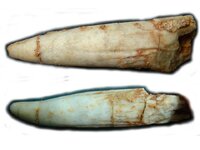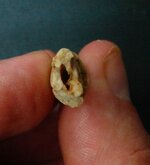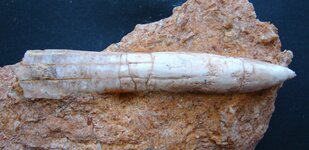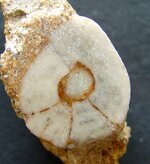- Joined
- Mar 7, 2009
- Messages
- 542
Greetings cephalopodologists,
I join this forum with a question about Eocene coleoids.
I found the attached calcitic belemnite in rocks which have always been considered as Eocene. They occur above the basal conglomerates which rest on the Oman ophiolite in Muscat. The belemnite is 40 mm long, 10 mm high and 7 mm wide. There is a symmetrically arranged pair of grooves, one deep, one shallow. The shell around the alveolus (which is empty of phragmocone) is crushed. The preservation of this anterior end of the fossil indicates that it has not been reworked. Accompanying fauna is dominated by a diverse and abundant suite of gastropods and fewer bivalves. Sparse isolated colonial corals (upside down the ones I saw) occur in the interval this one came out of.
So,
1) Does anyone recognize this individual to genus or better? (I can make drawings to clarify the pattern of grooves if this helps)
2) What's current status on the survival of belemnites into the Paleogene?
Thanks for your help!
I join this forum with a question about Eocene coleoids.
I found the attached calcitic belemnite in rocks which have always been considered as Eocene. They occur above the basal conglomerates which rest on the Oman ophiolite in Muscat. The belemnite is 40 mm long, 10 mm high and 7 mm wide. There is a symmetrically arranged pair of grooves, one deep, one shallow. The shell around the alveolus (which is empty of phragmocone) is crushed. The preservation of this anterior end of the fossil indicates that it has not been reworked. Accompanying fauna is dominated by a diverse and abundant suite of gastropods and fewer bivalves. Sparse isolated colonial corals (upside down the ones I saw) occur in the interval this one came out of.
So,
1) Does anyone recognize this individual to genus or better? (I can make drawings to clarify the pattern of grooves if this helps)
2) What's current status on the survival of belemnites into the Paleogene?
Thanks for your help!


 to TONMO Hajar
to TONMO Hajar


